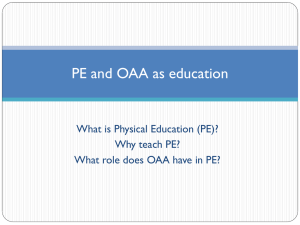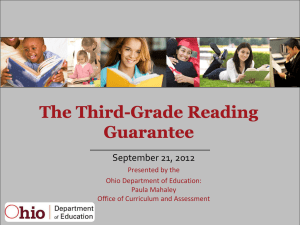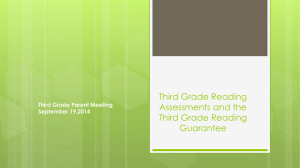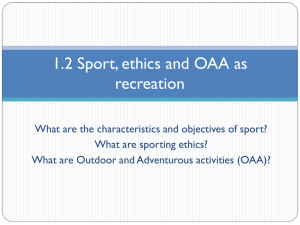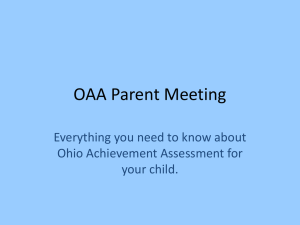Third Grade Reading Guarantee
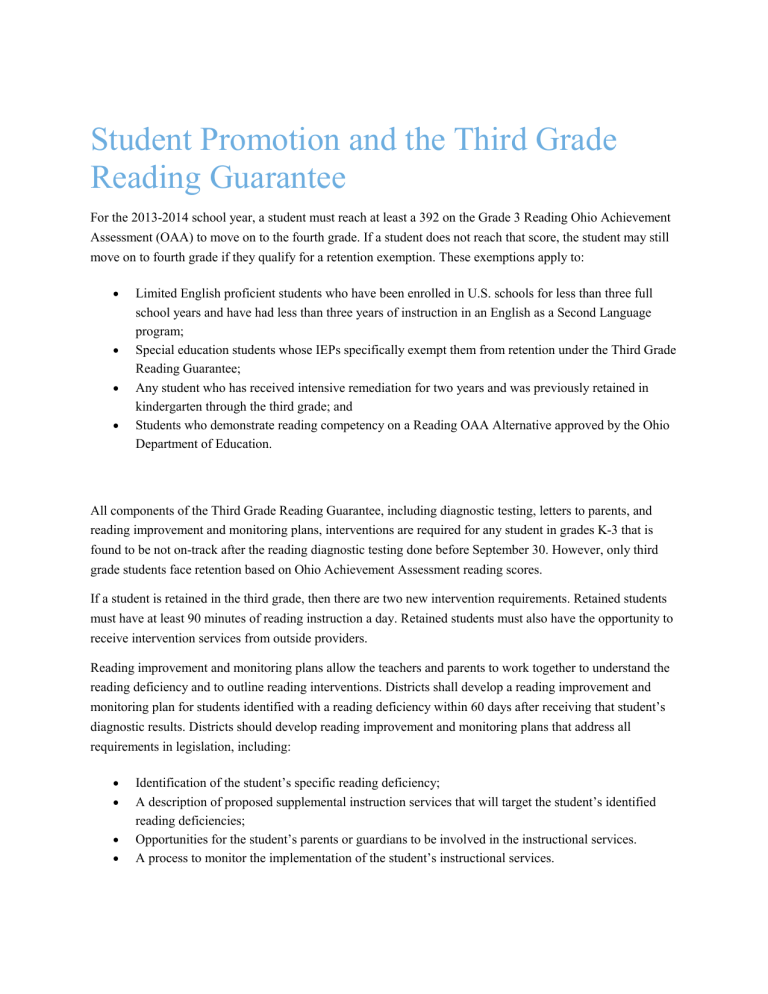
Student Promotion and the Third Grade
Reading Guarantee
For the 2013-2014 school year, a student must reach at least a 392 on the Grade 3 Reading Ohio Achievement
Assessment (OAA) to move on to the fourth grade. If a student does not reach that score, the student may still move on to fourth grade if they qualify for a retention exemption. These exemptions apply to:
Limited English proficient students who have been enrolled in U.S. schools for less than three full school years and have had less than three years of instruction in an English as a Second Language program;
Special education students whose IEPs specifically exempt them from retention under the Third Grade
Reading Guarantee;
Any student who has received intensive remediation for two years and was previously retained in kindergarten through the third grade; and
Students who demonstrate reading competency on a Reading OAA Alternative approved by the Ohio
Department of Education.
All components of the Third Grade Reading Guarantee, including diagnostic testing, letters to parents, and reading improvement and monitoring plans, interventions are required for any student in grades K-3 that is found to be not on-track after the reading diagnostic testing done before September 30. However, only third grade students face retention based on Ohio Achievement Assessment reading scores.
If a student is retained in the third grade, then there are two new intervention requirements. Retained students must have at least 90 minutes of reading instruction a day. Retained students must also have the opportunity to receive intervention services from outside providers.
Reading improvement and monitoring plans allow the teachers and parents to work together to understand the reading deficiency and to outline reading interventions. Districts shall develop a reading improvement and monitoring plan for students identified with a reading deficiency within 60 days after receiving that student’s diagnostic results. Districts should develop reading improvement and monitoring plans that address all requirements in legislation, including:
Identification of the student’s specific reading deficiency;
A description of proposed supplemental instruction services that will target the student’s identified
reading deficiencies;
Opportunities for the student’s parents or guardians to be involved in the instructional services.
A process to monitor the implementation of the student’s instructional services.
A reading curriculum during regular school hours that assists students to read at grade level, provides for reliable assessments, and provides ongoing analysis of each student’s reading progress; and
A statement that unless the student attains the appropriate level of reading competency by the end of grade three, the student will be retained.
Beyond the legislative requirements, ODE recommends that reading improvement and monitoring plans include a process for modifying the plan. It also should address how interventions should change for a student if he or she can read at grade level midyear.
When can a student be considered on-track during the year and can they be changed to not on-track during the year for any reason?
If a student is assessed to be not on-track at the beginning of the school year (for the September 30 deadline), that student will officially be not on-track and on a reading improvement and monitoring plan until the student either scores on-track on the following year’s reading diagnostic assessment or scores proficient (scoring 400 or higher) on the Grade 3 Reading Ohio Achievement Assessment.
If the student scores on-track on another reading diagnostic during the same school year, it does not terminate the reading improvement and monitoring plan. Within the reading improvement and monitoring plan, parents and teachers should address what happens to a student if he or she can read at grade level during the year. The reading interventions may need to change at that point. The plan should always help a student improve their reading ability and ensure the student does not fall behind.
What happens if a parent refuses interventions or retention required by the Third Grade Reading
Guarantee?
The law does not provide a parent the right to refuse the requirements of the Third Grade Reading Guarantee.
This includes student retention, diagnostic assessments, reading improvement and monitoring plans, and intervention services.
OAA ALTERNATIVE
The OAA Alternative will be a summative reading assessment aligned to end of year third grade standards. A student must achieve whatever the assessment designates as proficient in order to move on to the fourth grade.
This will be comparable or more rigorous than the proficient score on the Reading OAA.
A short list of OAA alternatives will be released by ODE in February 2014.
Districts may administer these alternative assessments at any time during the student’s third grade year.
Districts should administer an alternative assessment to a student that has scored below the cut score on the spring administration of the OAA if the student’s parents request it.
The district is responsible for the cost of the OAA alternative assessment.
Districts may continue to administer the OAA alternatives through the summer. A student scoring proficient will be promoted to the fourth grade before school starts in the fall.
SUMMER PROMOTION
If a student scores below 392 on the fall and spring reading OAAs (scores return in June) and did not demonstrate proficiency on an OAA alternative, it is recommended that the student continue to receive intensive reading remediation services appropriate for the student’s reading deficiency through the summer. If the student can demonstrate reading proficiency on the state assessment at the end of the summer, the student will be promoted to the fourth grade before school starts in the fall.
Districts will be able to administer a new standardized reading assessment provided by ODE. It will act as a summer version of the Grade 3 Reading OAA.
The administration of the summer exam will be the same as the spring OAA with regard to administration procedures and the cost of the assessment.
Students will be required to reach the retention cut score (e.g., 392) in order to qualify for summer promotion.
Students who receive a summer promotion should continue to receive appropriate reading intervention in the fourth grade.
STUDENT REENTERS THE THIRD GRADE
If the student does not demonstrate proficiency in reading during the summer, then the student will be considered a retained student. The student will enter the third grade for the second time. Any promotion after the start of the school year, even as early as September, would be a midyear promotion.
MIDYEAR PROMOTION
Any student retained by the Third Grade Reading Guarantee is eligible to be promoted during that school year in accordance with the district’s established midyear promotion policy.
Districts that believe a student may be eligible to be promoted midyear are encouraged to offer that student appropriate fourth grade instruction in all other subject areas. This will help ensure the student is academically prepared in the other subject areas when promoted midyear. The district will determine the appropriate fourth grade instruction for the student by:
Determining the measures that will be used to assess proficiency in each subject; and
Assessing whether the student can demonstrate proficiency in “end of third grade standards” for mathematics, science and/or social studies.
Any retained student who demonstrates proficiency in a subject area above a third grade level must receive the appropriate grade level instruction in that subject area. Although a student may receive appropriate fourth grade instruction in the other subject areas, the student will still be considered a third grade student unless promoted midyear or formally accelerated.
If a student received fourth grade appropriate instruction during their retained third grade year, but did not meet the requirements for midyear promotion, the student will enter fourth grade the following year, and potentially have a stronger foundation in the other subject areas.
Once a student is promoted midyear, they are considered a fourth grade student in all subjects and will take the fourth grade state assessments.
Legal Foundation (3313.608)
OAA ALTERNATIVE
(A)(2) … No school district shall promote to fourth grade any student who does not attain at least the equivalent level of achievement designated under division (A)(3) of section 3301.0710 of the Revised Code on the assessment prescribed under that section to measure skill in English language arts expected at the end of third grade, unless one of the following applies:
(c) The student demonstrates an acceptable level of performance on an alternative standardized reading assessment as determined by the department of education.
SUMMER PROMOTION
(B)(3)(c) … If the student participates in the remediation services and demonstrates reading proficiency in accordance with standards adopted by the department prior to the start of fourth grade, the district shall promote the student to that grade.
MIDYEAR PROMOTION
(B)(3) For each student retained under division (A) of this section, the district shall do all of the following:
(b) Establish a policy for the mid-year promotion of a student retained under division (A) of this section who demonstrates that the student is reading at or above grade level
FOURTH GRADE INSTRUCTION
(B)(4) For each student retained under division (A) of this section who has demonstrated proficiency in a specific academic ability field, each district shall provide instruction commensurate with student achievement levels in that specific academic ability field. As used in this division, "specific academic ability field" has the same meaning as in section 3324.01 of the Revised Code.
